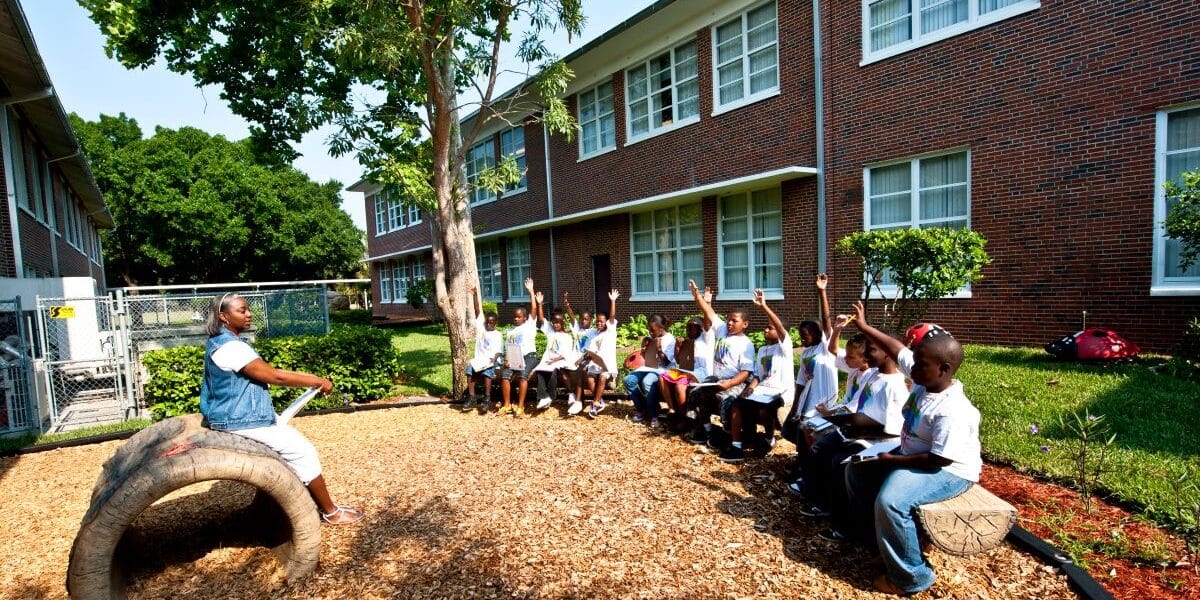Through our global collaboration with schools, we’ve gained valuable insights from principals and educators who consistently strive to enhance learning experiences, optimize facility use and create environments that support students’ academic and personal growth.
One innovative approach that has gained momentum is the concept of outdoor classrooms. These unique spaces not only offer a fresh, engaging learning experience but also provide a multitude of health and educational benefits. Outdoor classrooms are proving to be a wise investment for schools seeking to create flexible, safe and stimulating learning environments.
Physical and Mental Benefits of Outdoor Learning
We’ve long known the benefits of being outdoors—improved mood, enhanced immune function, reduced anxiety and even better cardiovascular health. For students, these benefits are magnified. Time spent outdoors reduces stress and improves concentration, which can directly enhance learning outcomes. Fresh air, sunlight and the natural surroundings can invigorate both students and teachers, making lessons more engaging and productive.
Outdoor classrooms can also support physical well-being by encouraging more movement. Students are less confined, leading to increased opportunities for physical activity. With childhood obesity and sedentary behavior being significant concerns, the outdoor classroom provides a space that naturally promotes healthier habits.
As students move freely in the outdoor environment, they experience a boost in energy, and teachers can more easily incorporate physical activity into their lessons, contributing to better overall health and academic performance.
Maximizing Campus Space and Flexibility
In addition to the personal benefits, outdoor classrooms offer a practical solution for schools looking to maximize the use of their campus space. Many schools have courtyards, fields and other outdoor areas that are underutilized. Transforming these areas into educational spaces allows schools to expand their usable square footage without the need for major construction projects.
With creative planning, an outdoor classroom can become a dynamic extension of the indoor environment, offering a multi-functional space that can serve as a classroom, performance area or even a place for quiet reflection.
This flexibility can be particularly useful in times when schools must adjust to fluctuating class sizes. An outdoor classroom can easily accommodate various group sizes and configurations, providing schools with a versatile space that can adapt to changing needs.
Designing an Outdoor Learning Environment
Designing an outdoor classroom is an exciting opportunity to rethink how students engage with their learning environment. It begins with the selection of appropriate furniture and equipment to create a functional yet inviting space. Since traditional indoor furniture may not withstand the elements, many schools are turning to durable, weather-resistant options specifically designed for outdoor use.
Seating and Desks: Outdoor seating can range from traditional benches to picnic tables or a log bench, which is sculpted from concrete, that fits a more nature-inspired theme. Durable materials such as steel, recycled plastic, composite wood or concrete ensure that these seating solutions can withstand varying weather conditions, making them a long-lasting investment. Desks, made from similar weather-resistant materials, can be fixed or mobile, allowing schools to customize their setup based on the lesson or activity.
Shelter and Shade: Commercial shade structures are another critical component of an outdoor classroom, ensuring students and teachers remain comfortable during sunny days. Commercial-grade shade sails or canopies can provide ample coverage, protecting against UV rays while still allowing plenty of natural light. These structures come in various sizes and designs, allowing schools to choose solutions that best fit their available space and budget.
Engaging Learning Tools for Active Participation
An outdoor classroom presents unique opportunities for interactive, hands-on learning. The space can be used to reinforce lessons learned inside the classroom by giving students the chance to experience concepts in real-time, often through direct interaction with the environment.
Gardens and Science Stations: School gardens or designated science stations are perfect for teaching biology, botany, and ecology. Students can observe plant growth, conduct soil tests and measure weather patterns, making abstract concepts tangible. Raised garden beds, composting bins, and weather observation equipment can be easily integrated into outdoor classroom spaces, allowing for ongoing, interactive science lessons.
Outdoor Musical Instruments and Performance Areas: Incorporating areas for creativity and self-expression is also crucial. Outdoor musical instruments, designed for durability and ease of use, provide an engaging way for students to explore music and rhythm. Chimes, xylophones and drums can be strategically placed in the classroom area, allowing for impromptu music sessions or structured lessons. Performance spaces like small stages or amphitheaters can serve multiple purposes—whether for drama classes, school assemblies or group presentations.
Fitness Equipment: Physical fitness can be integrated into the outdoor classroom experience with fitness equipment like outdoor exercise stations, ninja warrior-like courses or circuit fitness. Fitness zones placed adjacent to learning areas offer students an opportunity to burn off energy between lessons or participate in structured physical education activities. These spaces can be designed to challenge students’ physical abilities while promoting teamwork and self-confidence.
A Vision for the Future
The creation of outdoor classrooms presents a unique opportunity for schools to expand their learning environments in a way that supports student health, enhances engagement and maximizes campus space. By designing thoughtfully and integrating flexible, durable products, schools can create outdoor learning spaces that inspire students and provide them with opportunities to connect with nature, collaborate with peers, and explore subjects in new and exciting ways.
Embracing outdoor learning not only expands physical space but also opens new possibilities for hands-on education and holistic student development. The outdoor classroom is a testament to the power of nature in shaping the way students learn.
This article is courtesy of Landscape Structures Inc. (LSI), a leading manufacturer of commercial playground equipment since 1971. Their employee-owned company designs community and school playgrounds that encourage kids of all ages and abilities to learn persistence, leadership, competition, bravery, support and empathy through play, www.playlsi.com.










